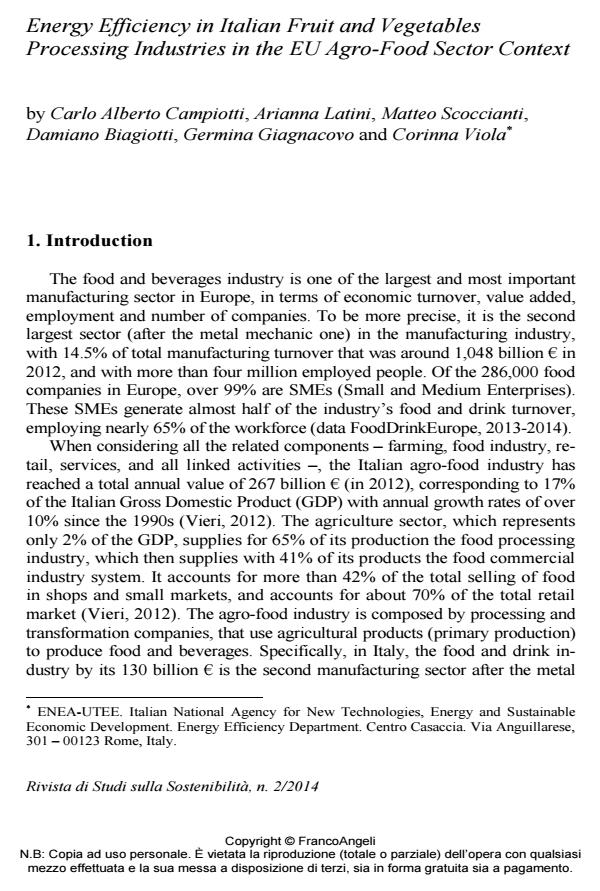Energy Efficiency in Italian Fruit and Vegetables Processing Industries in the EU Agro-Food Sector Context
Titolo Rivista RIVISTA DI STUDI SULLA SOSTENIBILITA'
Autori/Curatori Carlo Alberto Campiotti, Arianna Latini, Matteo Scoccianti, Damiano Biagiotti, Germina Giagnacovo, Corinna Viola
Anno di pubblicazione 2014 Fascicolo 2014/2
Lingua Inglese Numero pagine 16 P. 159-174 Dimensione file 259 KB
DOI 10.3280/RISS2014-002010
Il DOI è il codice a barre della proprietà intellettuale: per saperne di più
clicca qui
Qui sotto puoi vedere in anteprima la prima pagina di questo articolo.
Se questo articolo ti interessa, lo puoi acquistare (e scaricare in formato pdf) seguendo le facili indicazioni per acquistare il download credit. Acquista Download Credits per scaricare questo Articolo in formato PDF

FrancoAngeli è membro della Publishers International Linking Association, Inc (PILA)associazione indipendente e non profit per facilitare (attraverso i servizi tecnologici implementati da CrossRef.org) l’accesso degli studiosi ai contenuti digitali nelle pubblicazioni professionali e scientifiche
The food and beverages industry is a leading manufacturing sector in Europe. In 2012, the Italian agro-food industry, including farming, food industry, retail, services, and other related components, has reached the 17% of GDP. In terms of energy consumption, the whole agro-food system consumes large amounts of fossil fuels for the production of vegetable and animal food. This paper draws attention to the agro-food industry in Italy and in the European context, exploring more in details the fruit and vegetables industrial sector. Main measures, policies and technologies determining energy consumption in the agro-food industry are focused. Furthermore, available energy efficiency improvement tools and feasible ways to efficiently manage most of energy consumptions are discussed.
L’industria alimentare e delle bevande rappresenta un settore manifatturiero leader in Europa. Nel 2012, l’industria agroalimentare italiana, includendo agricoltura, industria di trasformazione, vendita al dettaglio, servizi e altre componenti correlate, ha raggiunto il 17% del PIL nazionale. L’intero sistema agroalimentare consuma ingenti quantità di combustibile fossile. Questo manoscritto esamina il comparto dell’industria agroalimentare in Italia e nel contesto europeo, focalizzando sul settore ortofrutticolo, e trattando le principali misure, linee politiche e tecnologie che determinano i consumi di energia nell’industria agroalimentare. Inoltre, vengono discussi alcuni strumenti disponibili per migliorare l’efficienza energetica ed una gestione più efficiente dei consumi energetici.
Parole chiave:Industria agroalimentare, efficienza energetica, agricoltura, consumo energetico, energie rinnovabili
- Campiotti C.A., Alonzo G., Ardeleanu P.M. (2013). Energy challenge and agriculture in Italy. Quality-Access to Success, 14, S1, March: 18.
- Campiotti C.A., Viola C., Scoccianti M., Alonzo G. (2012). Agroalimentare e sviluppo economico sostenibile: energia, efficienza energetica, ambiente e cibo. Rivista di Studi sulla Sostenibilità, 2: 69-86, DOI: 10.3280/RISS2012-SU2006
- Cleland D. (2010). Toward a sustainable cold chain. International Institute of Refrigeration, Cambridge, UK. March.
- CNEL (2011). Commissione per le politiche del lavoro e dei settori produttivi (II). Osservazioni e proposte. Seduta deliberante, 20.12.2011.
- COPA COGECA. Fruit and Vegetable Producer Organisations in the EU: Overview and Prospects (http://www.copa-cogeca.be/img/user/7493_E.pdf).
- ENEA (2013). Current process description – Fruit and Vegetables Processing Plants. Tesla Project deliverable (www.teslaproject.org).
- ENEA. RAEE (2011). Rapporto Annuale Efficienza Energetica. Dicembre 2012.
- ENEA. RAEE (2012). Rapporto Annuale Efficienza Energetica. Dicembre 2013.
- European Commission-DG ENV-Directorate C (2010).
- European Parliament. Directorate-General for Internal Policies (2014). Risks and opportunities for the EU agri-food sector in a possible EU-US trade agreement. FAO (2011). Global food losses and food waste.
- FAO C(2011a). Save and grow. A policy maker’s guide to the sustainable intensification of small holder crops production.
- FoodDrinkEurope (2013-2014). Data & trends of the European Food and Drink Industry. Galitsky C. (2003). Energy efficiency improvement and cost saving opportunities for the corn wet milling industry: an Energy Star guide for energy and plant managers. Report LBNL-52307. Ernest Orlando Lawrence Berkeley National Laboratory. USA.
- Garnett T. (2006). Wise moves: exploring the relationship between food, transport and CO2. Transport 2000, London.
- Giampietro M. (2003). Energy Use in Agriculture. In: eLS, John Wiley & Sons Ltd, Chichester. http://www.els.net, DOI: 10.1038/npg.els.0003294
- Gustavsson J., Cederberg C., Sonesson U., van Otterdijk R., Meybeck A. (2011). Global food losses and food wastes – extent, causes and prevention. www.fao.org.
- Hill H. (2008). Food miles: background and marketing. ATTRA.
- Kaminski J., Leduc G. (2010). Energy efficiency improvements options for the EU food industry. Polityka Energetyczna. Tom 13, zeszyt 1.
- L’Italia Agricola (1988). Energie alternative e risparmio energetico in agricoltura. Ed. REDA.
- Latini A., Viola C., Scoccianti M., Campiotti C.A. (2014a). An energetic outlook of the Italian food and drink industry. Quality-Access to Success, 15, S1, March: 333.
- Latini A., Viola C., Scoccianti M., Campiotti C.A. (2014b). Efficient Fruit and Vegetables Processing Plants Handbook. Tesla Project deliverable
- (www.teslaproject.org). IEE/12/758/S12.644752. Legge A., Orchard J., Graffham A., Greenhalgh P., Kleih U. (2006). The production of fresh produce in Africa for export to the Unided Kingdom: mapping different value chains. Natural Resources Institute.
- LG MTD Industria Alimentare (2008). Linee guida per l’identificazione delle migliori tecniche disponibili, marzo.
- Ortego A., Gutiérrez J.I., Calvo M. (2014). Best Practices Collection. Tesla Project deliverable (www.teslaproject.org).
- PFE (1989), Le richieste d’energia del sistema agricolo italiano.
- Smil V. (2008). Energy in nature and society – general energetic of complex systems. MIT Press, Cambridge, MA.
- SRM (2013). Un Sud che innova e produce. Vol. 2. La Filera agroalimentare. Giannini, Napoli.
- Vieri S. (2012). Agricoltura. Settore multifunzionale allo sviluppo. Edagricole, Milano.
- Energetic and Environmental Sustainability of the food agriculture system Carlo Alberto Campiotti, Arianna Latini, Germina Giagnacovo, Joaquín Fuentes-Pila, Matteo Scoccianti, in RIVISTA DI STUDI SULLA SOSTENIBILITA' 2/2019 pp.105
DOI: 10.3280/RISS2018-002007 - Energy End-Use Categorization and Performance Indicators for Energy Management in the Engineering Industry Fayas Kanchiralla, Noor Jalo, Simon Johnsson, Patrik Thollander, Maria Andersson, in Energies /2020 pp.369
DOI: 10.3390/en13020369
Carlo Alberto Campiotti, Arianna Latini, Matteo Scoccianti, Damiano Biagiotti, Germina Giagnacovo, Corinna Viola, Energy Efficiency in Italian Fruit and Vegetables Processing Industries in the EU Agro-Food Sector Context in "RIVISTA DI STUDI SULLA SOSTENIBILITA'" 2/2014, pp 159-174, DOI: 10.3280/RISS2014-002010